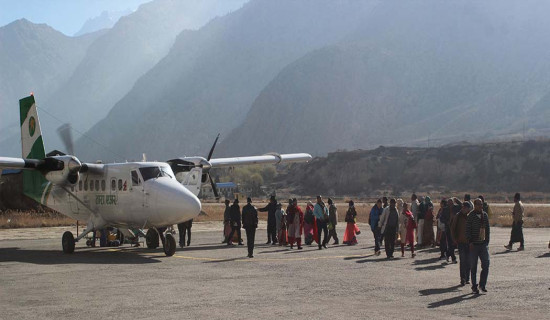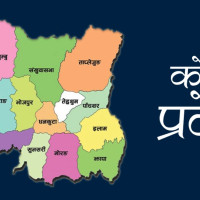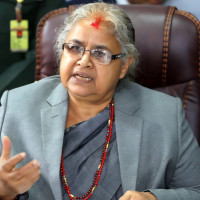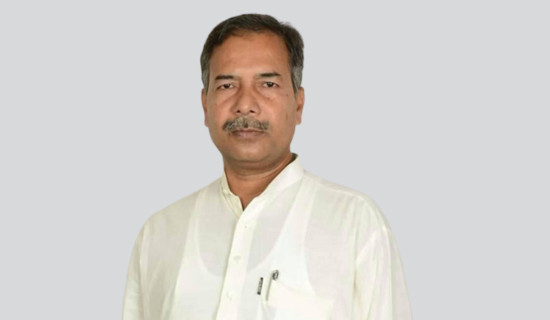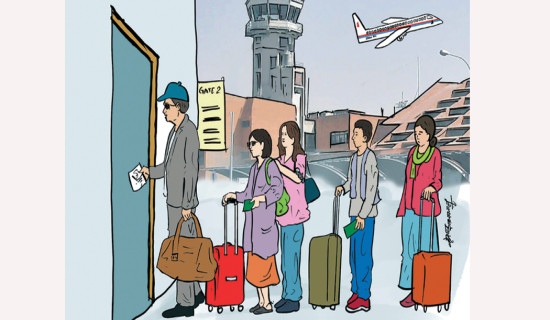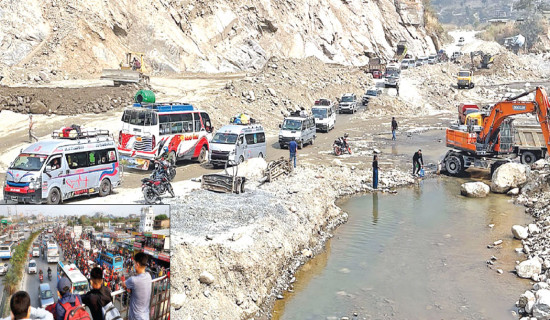- Thursday, 25 December 2025
Nepal faces soaring air safety concerns amid repeated crashes
KATHMANDU, AUG. 4: On July 24, 2024, a Saurya Airlines aircraft which had just taken off for Pokhara crashed on the premises of Tribhuvan International Airport (TIA).
All 18 passenger-cum staff of the Airlines on board lost their lives. The officials have even said that the aircraft had been on the ground for 30 days and was going for C-check to Pokhara, using a hangar there during its month-long maintenance.
This is the 11th crash (after Sita Air’s aircraft killing 19 onboard on September 28, 2012, Turkish Air on March 5, 2015 that carried 224 passengers but with no human casualty, and US-Bangla Air crash on March 12, 2018, killing 51 of 71 passengers onboard) that happened inside the Kathmandu Valley or inside the TIA, not involving a collision with a remote or high mountain.
After Saurya Airlines aircraft accident has once again raised concerns about the safety and risk levels of Nepal’s air routes. Although this debate surfaces after every aviation debacle, it often fades away without addressing the issues so as to enhance air safety.
The discussions rarely focus on the inherent weaknesses in air safety, which are considered contributing factors to the increase in air service accidents. Much of the time is spent on superficial debates and discussions.
Despite being consigned in a shroud of one tragedy after another, there remains a persistent and absurd argument that Nepal’s aviation sector is one of the safest in the world and technically sound.Nepal may be at the forefront of the world when it comes to witnessing air accidents frequently. Why do air accidents occur repeatedly in such a short time? Technical reasons or human errors are generally attributed for repeated accidents.
But, should the role of the regulatory body of the aviation sector be linked with air accidents or not? The regulatory body of the country’s aviation sector is the Civil Aviation Authority of Nepal (CAAN), but it is also tasked with service handling.
Almost all air accidents in Nepal must be viewed in relation to the aviation safety regulations of the CAAN. Is the regulatory authority’s weakness the solely responsible or is it the fault of the airline operators?
Experts', former CAAN officials’ take on air safety
“Being both the regulatory and service providing body, the role of the CAAN is the most vital to prevent air accident,” said Dim Prakash Poudel, a former Managing Director for the Nepal Airlines.
“The Authority is responsible for certifying pilots, checking whether planes or helicopters are airworthy, and ensuring that the airport is in proper condition. It is clearly evident that there have been some shortcomings in this regard recently,” Poudel said.
The regulatory body is responsible for making air transport in any country completely safe. Its first and foremost priority is aviation safety, and it ensures strict adherence to safety standards, said Poudel.
The Authority certifies pilots who fly planes or helicopters, licenses airworthiness, and grants permission to air traffic controllers (ATCs), airline companies, and others.
“The Authority is responsible for conducting audits and inspections from time to time on whether airline companies are operating according to the regulations and whether aviation rules are strictly followed,” he said. “However, recently, the Authority seems to be more focused on providing services rather than on regulatory work. This can be considered as compromising aviation safety,” he said. Unless the Authority is divided separating regulator and service provider tasks, regulatory negligence will continue to persist, claimed Sanjiv Gautam, former DG of CAAN.
Similarly, a senior official working at the CAAN, on condition of anonymity, said the government itself was working against the separation of the authority. He further accused the government of acting wrongly by not registering the bill to split the Authority (regulatory and service providing) in the Lower House, which had been already passed by the National Assembly.
He said that the International Civil Aviation Organisation (ICAO), the umbrella organisation of civil aviation authorities worldwide, had already pointed out the regulatory weaknesses of the CAAN. Although Nepal’s airspace has been removed from the International Civil Aviation Organization (ICAO) blacklist seven years ago, it has not been removed from the European Union (EU).
“To address the complexities of aviation safety in Nepal, the authority lacks sufficient, experienced, and skilled personnel,” ICAO had stated a few years ago.
For aviation safety in Nepal, there are two types of systems: the Safety Management System (SMS) and the State Safety Programme (SSP).
The SMS covers air service providers and airports, while the SSP covers the regulatory body or the state. Due to the weakness of the SSP, ICAO had blacklisted Nepal a few years ago.
Similarly, due to the internal problems within the aviation regulator, Europe Union has not allowed aircraft registered in Nepal to enter its airspace for over a decade since December, 2013.
Dr. Dipak Prasad Bastola, an air safety expert and former Brigadier General of Nepali Army, said that because of the weak regulation mechanism of the CAAN, aviation safety is reaching a critical point. Dr. Bastola, who has also worked in several air crash investigation commissions, said if the Authority did not become aware in time to address this, more difficult situations would arise.
The main concerns for Nepal are that Nepali aviation has not been removed from the EU’s blacklist, there has not been a decrease in air accidents, and the Civil Aviation Authority’s unwillingness to separate the roles of service provider and regulator. These issues have repeatedly engendered questions about the authority’s leadership and staff, he said.
Involving an airplane crash, be it inside the airport or outside difficult terrain of the country, is a matter of misfortune or bad luck of the aircraft itself, said Tri Ratna Manandhar, former Director General and member of several airplane crash investigation commissions.
“Regulatory body cannot take all the responsibilities at all the time which is also the same in the other countries, instead all airlines and operators should act responsibly and accountably to avert any such unimaginable incident,” said Manandhar.
Hansa Raj Pandey, Deputy Director General and Spokesperson for the CAAN, claimed that aviation safety was always the Authority’s primary objective. “Aviation safety is our first and foremost priority,” Pandey told The Rising Nepal. “Therefore, there will be no compromise in aviation safety under any circumstances.”
According to him, a safe aviation sector is created by the convergence of airline companies, airport infrastructure, airspace, and aircraft. Even though the airlines operator may be directly involved in an air accident, the Authority cannot simply distance itself from its responsibility.
He said that the Authority was primarily focused on Annex 1, 6, and 8 of ICAO. Annex 1 deals with individual flight licenses, Annex 6 with flight operations, and Annex 8 with airworthiness. The aviation safety mechanisms remain vigilant round the clock, Pandey claimed.
Regarding the accident involving Saurya Airlines aircraft, Deputy Director General Pandey conceded that “the captain has the right to not allow or say NO to any unrelated persons on board other than for technical reasons during a C-check flight”. “Pilot doesn’t have the authority outside the aircraft door, but inside the door, everything should be under his control,” Pandey said.
“The Authority’s entire focus is on aviation safety. There may be some procedural weaknesses in this regard. Nevertheless, accidents do occur, which is unfortunate. Overall, as a regulatory body, the Authority is a responsible entity,” said Pandey.
According to Aviation Safety Reporrt-2022 published by the CAAN, it had identified seven areas of operation safety risks and they include -- controlled flight into terrain (CFIT), loss of control in flight (LOC-I), mid-air collision (MAC), runway incursion (RI), runway excursion (RE), wildlife strike (WS) and abnormal runway contact (ARC). CAAN thus, is continuously monitoring the implementation of Nepal Aviation Safety Plan (NASP) to maintain utmost air safety protocols, said Pandey.
108th accident in Nepali skies, 959 dead
On July 24, 2024, the Nepali sky witnessed the 108th plane crash since 1955, resulting in 959 fatalities. That Saurya Airlines plane crash was the 54th domestic flight accident, according to the CAAN.
In Nepal, a total of 21 airline operators are in operation with nine of them operating fixed wing aircrafts, 12 operating rotor wing aircrafts and one operating a mixed fleet of fixed wing and rotor wing aircrafts.
Of the nine fixed wing operators, one is an exclusive international scheduled operator, three are in both domestic and international scheduled operations, and the rest are involved in scheduled domestic operations.



